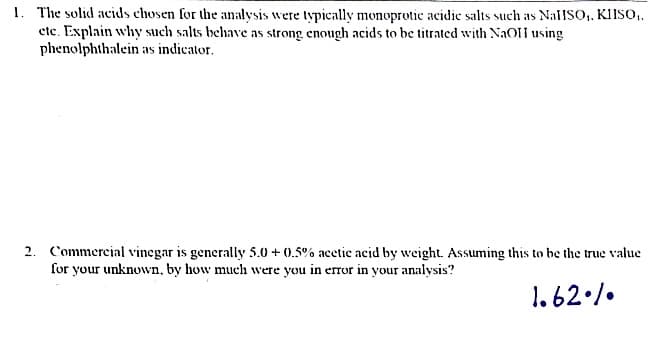1. The solid acids chosen for the analysis were typically monoprotic acidic salts such as NaIISO₁. KIISO₁. etc. Explain why such salts behave as strong enough acids to be titrated with NaOH using phenolphthalein as indicator. 2. Commercial vinegar is generally 5.0+ 0.5% acetic acid by weight. Assuming this to be the true value for your unknown, by how much were you in error in your analysis? 1.62./.
1. The solid acids chosen for the analysis were typically monoprotic acidic salts such as NaIISO₁. KIISO₁. etc. Explain why such salts behave as strong enough acids to be titrated with NaOH using phenolphthalein as indicator. 2. Commercial vinegar is generally 5.0+ 0.5% acetic acid by weight. Assuming this to be the true value for your unknown, by how much were you in error in your analysis? 1.62./.
Principles of Modern Chemistry
8th Edition
ISBN:9781305079113
Author:David W. Oxtoby, H. Pat Gillis, Laurie J. Butler
Publisher:David W. Oxtoby, H. Pat Gillis, Laurie J. Butler
Chapter20: Molecular Spectroscopy And Photochemistry
Section: Chapter Questions
Problem 67CP
Related questions
Question
Could you please help me with both questions. Please define the first question and for the second question how do I obtain the percent error. The measured value I found is 1.62%.
Thank You!

Transcribed Image Text:1. The solid acids chosen for the analysis were typically monoprotic acidic salts such as NalISO₁, KIISO₁.
etc. Explain why such salts behave as strong enough acids to be titrated with NaOH using
phenolphthalein as indicator.
2. Commercial vinegar is generally 5.0+ 0.5% acetic acid by weight. Assuming this to be the true value
for your unknown, by how much were you in error in your analysis?
1.62./.
Expert Solution
This question has been solved!
Explore an expertly crafted, step-by-step solution for a thorough understanding of key concepts.
This is a popular solution!
Trending now
This is a popular solution!
Step by step
Solved in 4 steps

Knowledge Booster
Learn more about
Need a deep-dive on the concept behind this application? Look no further. Learn more about this topic, chemistry and related others by exploring similar questions and additional content below.Recommended textbooks for you

Principles of Modern Chemistry
Chemistry
ISBN:
9781305079113
Author:
David W. Oxtoby, H. Pat Gillis, Laurie J. Butler
Publisher:
Cengage Learning



Principles of Modern Chemistry
Chemistry
ISBN:
9781305079113
Author:
David W. Oxtoby, H. Pat Gillis, Laurie J. Butler
Publisher:
Cengage Learning

